Not only is the television screen the focal point of many living rooms, but it has increasingly become the central control hub for those spaces. That has shifted how people think about audio in these rooms.
For many, the standard approach to sound involves a two-channel stereo system: a pair of speakers flanking the TV, usually a separate amplifier or receiver, and maybe a subwoofer. A $1000 stereo system can deliver genuinely impressive performance for both music and TV-viewing. But it’s limited to two channels, and for those who’d like a more immersive experience, regular stereo falls short.
The promise of surround has always been enticing: immersion, excitement, a little slice of cinema magic transplanted to the living room. But traditionally, that required an A/V receiver with five or more channels of amplification, and running speaker cables across floors, under rugs, or along baseboards.
Today, wireless digital technology can eliminate much of that hassle. But whether it’s a legitimate breakthrough or an expensive way to avoid running cables depends on your point of view, and your priorities.
What does wireless actually mean?
When we talk about “wireless surround sound,” what we’re talking about is wireless signal distribution. Audio for the surround channels doesn’t come down long cables from a multichannel A/V receiver, but is instead delivered over the air using Wi‑Fi, RF links, or other wireless protocols, which we’ll get into.
The speakers themselves are still tethered, though, not to your amp, but to wall outlets. Powered or active speakers are necessary for this all to work—these speakers’ built-in amplifiers have to get their power from somewhere. That tiny asterisk often gets glossed over in marketing materials, but it matters if your room has limited outlets near where you want to place your surround speakers.
How does it work?
Modern wireless surround systems typically follow this signal path: A source device (streaming stick, Blu‑ray player, game console) outputs multichannel digital audio to a TV, receiver, soundbar, or networked audio device that acts as the central audio hub. This hub decodes the audio surround format and distributes the channels wirelessly to speakers positioned around the room. Synchronization protocols ensure all channels play at precisely the right moment.
There are three main approaches to wireless surround that predominate in today’s market:
Dedicated RF links use proprietary transmitter–receiver pairs designed for ultra-low latency, often under ten milliseconds. TV manufacturers like Samsung and Sony frequently bundle wireless subs or rear speakers with soundbars that employ this technology. The short-range, purpose-built nature of these systems makes them ideal when you need the subwoofer’s thud to coincide perfectly with an on-screen explosion.
 Dynaudio’s Focus series of streaming active loudspeakers have built-in WiSA receivers, enabling them to receive audio from WiSA-compliant TVs and audio components
Dynaudio’s Focus series of streaming active loudspeakers have built-in WiSA receivers, enabling them to receive audio from WiSA-compliant TVs and audio components
Wi‑Fi offers high data throughput and is well-suited for high-quality audio. Platforms like AirPlay 2 and Chromecast use Wi‑Fi infrastructure, though they’re designed to stream content to a central receiver or soundbar rather than distribute multichannel surround wirelessly to individual speakers. AirPlay 2 transmits stereo only, while Chromecast can pass through multichannel audio via HDMI to compatible receivers. Proprietary systems from Sonos, WiiM, and Bluesound (via BluOS grouping) also use Wi‑Fi, but with their own protocols for synchronized multiroom or surround playback.
WiSA (Wireless Speaker and Audio) takes a different approach entirely. Unlike Wi‑Fi, which is a general-purpose networking protocol adapted for audio, WiSA is purpose-built for audio transmission—either stereo or surround. WiSA-compliant TVs from brands like LG can transmit uncompressed surround sound directly to WiSA-certified speakers with no separate hub required. The protocol operates in the 5GHz band but doesn’t share bandwidth with home network traffic. Brands like Klipsch, Bang & Olufsen, and Dynaudio manufacture WiSA speakers that receive up to 24‑bit/96kHz audio with claimed latency under 5 milliseconds. The system supports up to eight channels, making it viable for full 7.1 and 5.1.2 configurations. The tradeoff is ecosystem lock-in: you need both a WiSA-compatible source component and WiSA-certified speakers.
The latency problem
Latency has always been a big challenge for wireless digital audio. Even a 50-millisecond misalignment between video and sound, or between different speakers, can ruin cinematic immersion. We can typically detect lip-sync errors of around 40 milliseconds and upwards.
The best wireless systems today achieve latency under 20 milliseconds, which is imperceptible in practice. Manufacturers address synchronization through buffering, error correction, clock-synchronization protocols, and adaptive frequency hopping to avoid interference.
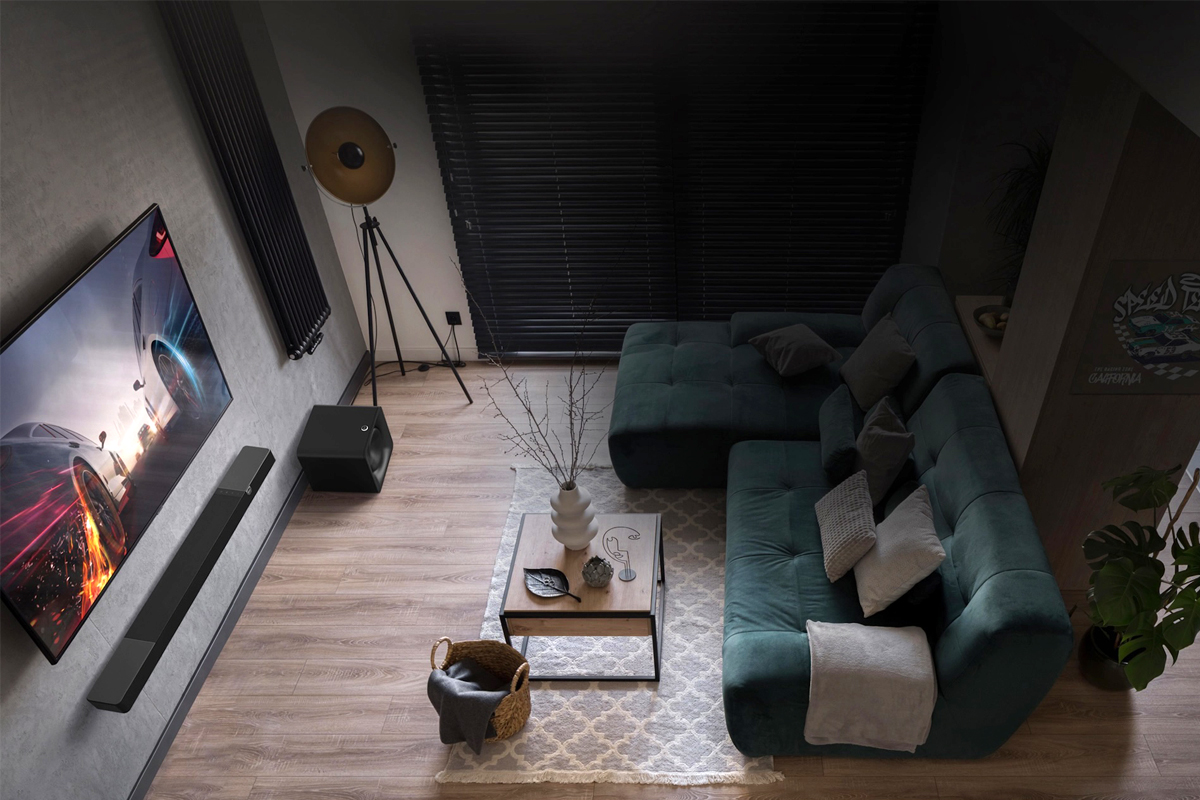 Klipsch’s new Flexus soundbars feature Klipsch Transport technology for sending wireless audio to Flexus surround speakers and subwoofers
Klipsch’s new Flexus soundbars feature Klipsch Transport technology for sending wireless audio to Flexus surround speakers and subwoofers
Standard Dolby Digital runs at 640kbps, while lossless Dolby TrueHD can reach 18Mbps. Wi‑Fi handles these bitrates easily, often exceeding 50 to 100Mbps. This bandwidth advantage is why Wi‑Fi and dedicated RF dominate the wireless surround market, while Bluetooth remains relegated to casual stereo listening and other non-time-sensitive applications.
System configurations
Wireless surround comes in several flavors:
Soundbar-based systems have become the gateway for general consumers. A single-unit speaker system connects to your TV via HDMI ARC, pairs with a wireless subwoofer, and can be expanded with wireless rear speakers. Brands like Samsung (Q-series), Sony (HT-A series), Bose, and Klipsch offer turnkey packages that deliver genuine surround with minimal effort.
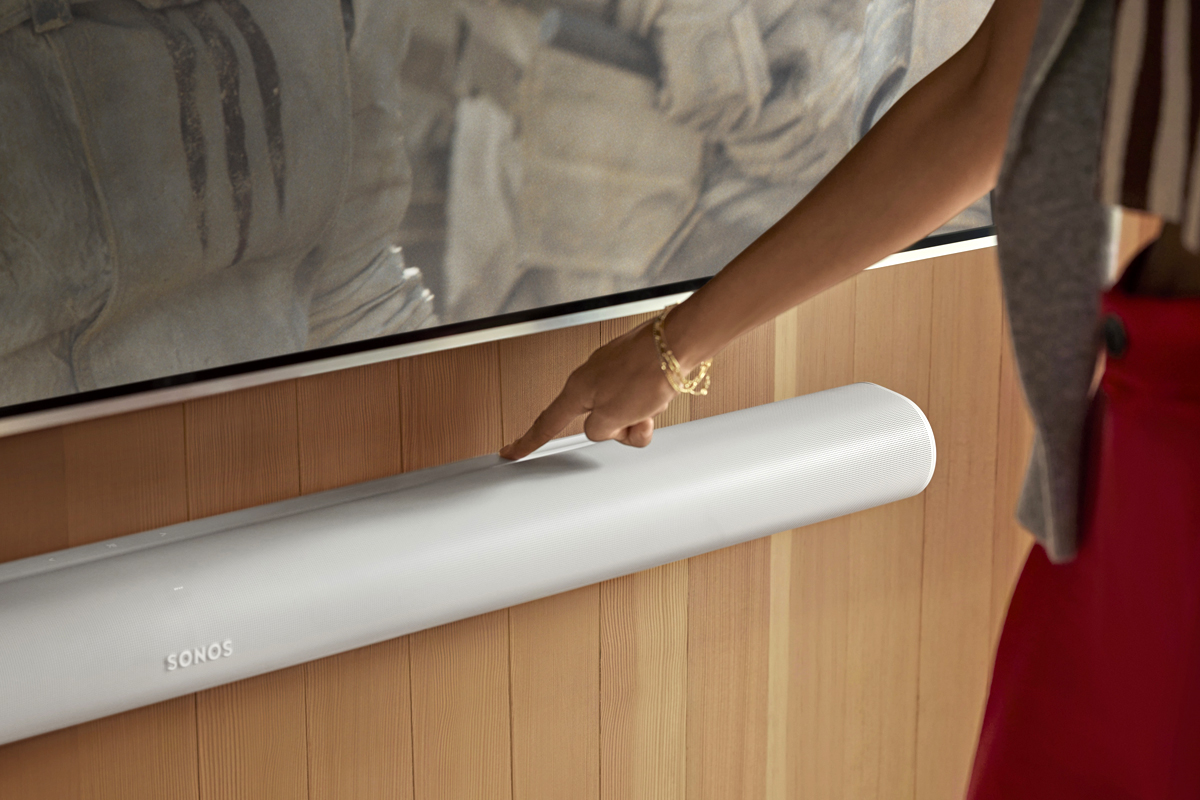 Sonos’s Arc Ultra soundbar can be paired wirelessly with a Sonos Sub 4 and a pair of the company’s wireless satellite speakers to create a 5.1-channel surround system
Sonos’s Arc Ultra soundbar can be paired wirelessly with a Sonos Sub 4 and a pair of the company’s wireless satellite speakers to create a 5.1-channel surround system
Modular ecosystems like Sonos excel at flexibility. Buy a soundbar (like Sonos’s Arc Ultra or Beam), add wireless rear speakers (Era 300, Era 100, or older models), pair a Sub 4, and you’ve built a complete 5.1-channel system through an app. Each component only needs a power outlet. The app assigns channels and ensures synchronized playback.
Network audio platforms from Bluesound (using BluOS) and WiiM take a different route. These systems build on high-resolution networked audio with multiroom capabilities. For surround, you connect a primary device like the Bluesound Powernode (2025) or WiiM Amp to your TV via HDMI ARC, then assign additional networked speakers or amplifiers within the same ecosystem as surround channels through the app. These solutions are especially appealing in that, if you already own one of these systems, you can add surround capabilities to your two-channel hi-fi system without compromising its performance in any way.
WiiM’s approach requires a Group Lead device (WiiM Ultra, WiiM Amp Pro, or WiiM Amp Ultra) connected to the TV’s HDMI ARC port, with the TV set to output Dolby Digital Audio. Additional WiiM devices (excluding the Mini, which isn’t supported) can be grouped in the WiiM Home app and assigned to specific surround roles: left/right surround, center, or combined channels. The subwoofer connects to the Group Lead device via an RCA cable.
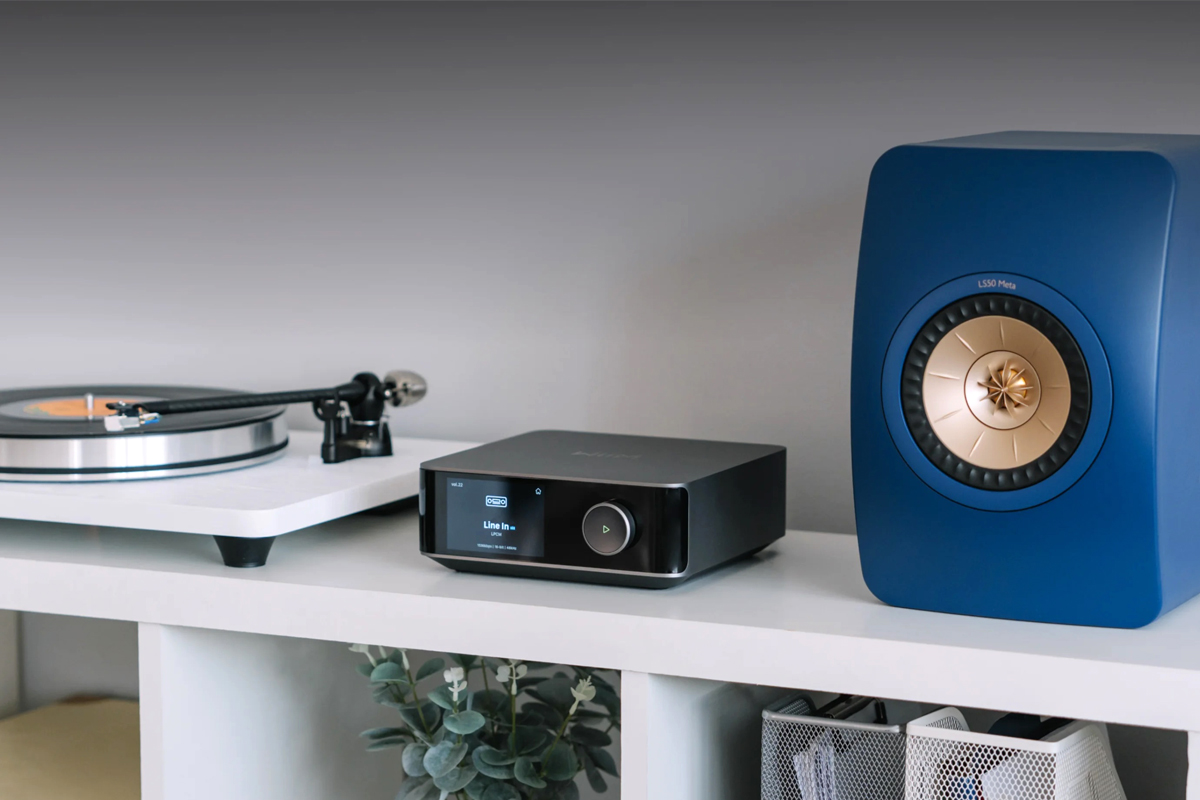 WiiM’s Ultra Amp can be grouped with other WiiM devices in the WiiM Home app to distribute sound for the surround channels wirelessly
WiiM’s Ultra Amp can be grouped with other WiiM devices in the WiiM Home app to distribute sound for the surround channels wirelessly
Bluesound uses the Powernode or a Pulse soundbar for the front channels. Wireless speakers like the Pulse Flex 2i or Pulse M can be designated as left- and right-surround speakers through the BluOS Controller app’s Home Theater Group feature. Bluesound also has a wireless subwoofer, the Pulse Sub+, so that listeners can configure a 5.1 setup with audio sent wirelessly to the sub, as well as the surround channels. The fixed grouping ensures synchronized, high-quality surround channels with control over crossover settings and listening profiles.
Some WiSA-enabled systems bypass traditional hubs entirely. You can pair WiSA-certified speakers directly to a compatible TV, and the TV handles distribution. This approach offers the cleanest setup: no receiver, no soundbar hub, just speakers and a TV that speaks the protocol. The catch is ecosystem lock-in. Standard configurations range from 5.1- and 7.1-channel to Dolby Atmos 5.1.2.
But there are also WiSA-compliant hubs. Platin Audio, which supplies the WiSA modules that are installed inside active speakers from Buchardt Audio, System Audio, and Triangle, also offers stereo and surround hubs that work with those systems—and with any WiSA loudspeaker. Platin’s surround hubs can transmit up to eight channels of audio, for 7.1-channel Dolby Digital or 5.1.2 Dolby Atmos immersive audio. The Stereo Hub HT, Surround Hub, and Surround Hub X have a broad range of inputs plus a built-in Roon Ready streamer that supports Apple AirPlay 2, Google Cast, Spotify Connect, Tidal Connect, and UPnP.
Making the case for wireless
There are three main reasons to pursue wireless surround:
Aesthetics: Clean walls and uncluttered floors are simply nicer to live with. For those in apartments or open-plan homes, the visual improvement alone justifies choosing wireless.
Flexibility: Reposition a speaker at will with no need to re-route a 25′ speaker cable. Room rearrangements become trivial.
Ease of entry: Soundbar bundles with two rears and a wireless sub allow consumers to step into genuine surround with a single purchase and minimal technical knowledge.
The caveats
Power cords: You’ve cut the speaker wire, but you haven’t eliminated cables altogether. Each wireless speaker still needs a power outlet. In practice, this means you’re trading long speaker cables for shorter power cables.
Interference happens: Microwaves, neighboring Wi‑Fi networks, and an overcrowded 2.4GHz spectrum can make even premium wireless systems stumble. Wi‑Fi 6 and 7 mitigate these issues, but they don’t eliminate them.
Fidelity ceiling: Purists will always favor dedicated, wired separates. Wireless subs and surrounds have improved dramatically, but a high-end wired system will usually outperform a wireless bundle at a similar price point.
App dependence: Some systems can function only through vendor-provided apps. When servers go down or companies abandon products, expensive speakers can become paperweights. This risk is real and has already bitten early adopters of discontinued platforms. Just ask anyone who bought into Bose’s SoundTouch technology.
Does surround live up to the hype?
The step up from TV speakers or a basic soundbar to a wireless surround package isn’t subtle. The improvement is most dramatic with films that feature aggressive surround mixing: action spectacles, sci‑fi epics, horror films that use rear channels for tension.
Music presents a different picture, however. While surround-music formats have been around for decades, most recently appearing on SACD, Blu‑ray Audio, and Dolby Atmos music on streaming platforms, they remain niche. The vast majority of music is mixed in stereo as a priority, with surround versions appearing as optional adaptations, if they exist at all. For music lovers, wireless surround offers little advantage unless you’re deeply invested in immersive music formats.
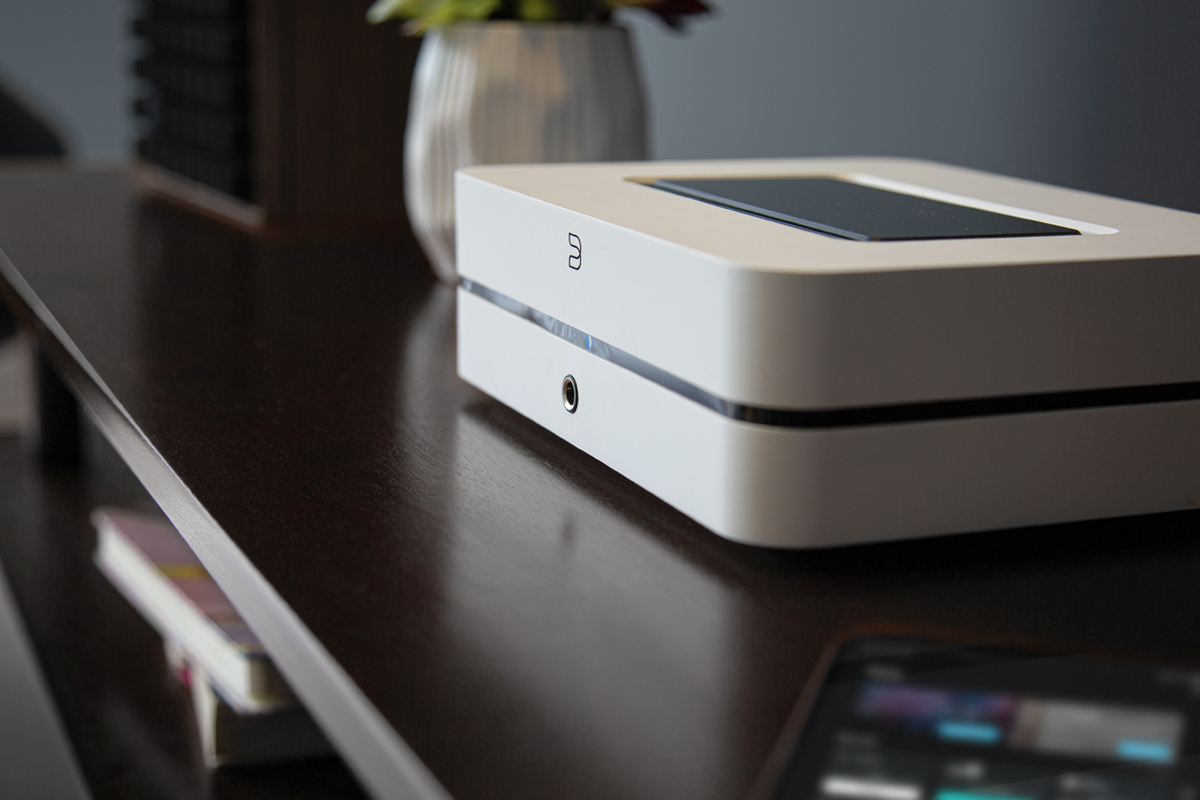 Bluesound’s 2025 Powernode streaming integrated amplifier can be used to power passive front left, center, and right speakers, and send wireless audio for the surround and low-frequency-effects channels to Bluesound Pulse speakers and a Pulse Sub+ subwoofer
Bluesound’s 2025 Powernode streaming integrated amplifier can be used to power passive front left, center, and right speakers, and send wireless audio for the surround and low-frequency-effects channels to Bluesound Pulse speakers and a Pulse Sub+ subwoofer
Live concert recordings can benefit from surround by incorporating crowd sounds and venue ambience, making listeners feel immersed as if they’re present at the event space. Certain genres like progressive rock, electronic, and experimental can leverage immersion for creative effect. But for the vast majority of music listening, stereo remains more than satisfactory for anyone with a decent system.
What’s next?
Wireless is only getting better. Wi‑Fi 6 and 7 reduce congestion headaches. Next-generation codecs promise lower latency and higher fidelity at modest bitrates. Battery-powered wireless surround speakers are beginning to appear, eliminating the need even for power cables during use (you dock them periodically for recharging).
In the next decade, home-theater setup may not involve a traditional receiver at all, just a self-organizing cluster of wireless speakers, each one aware of its placement in your room and capable of adjusting accordingly.
WiSA’s adoption by more TV manufacturers could accelerate this trend, particularly if the standard gains traction. The promise of pairing speakers wirelessly with your TV is compelling, but it requires buy-in from both TV makers and speaker manufacturers.
The bottom line
Wireless surround-sound systems deliver immersive audio without the need for tearing up carpets or the headache of in-wall cabling. Three-dimensional soundscapes are now achievable in family living spaces rather than dedicated theater rooms. The barrier to entry goes from “hire an installer” to “plug in some speakers and open an app.”
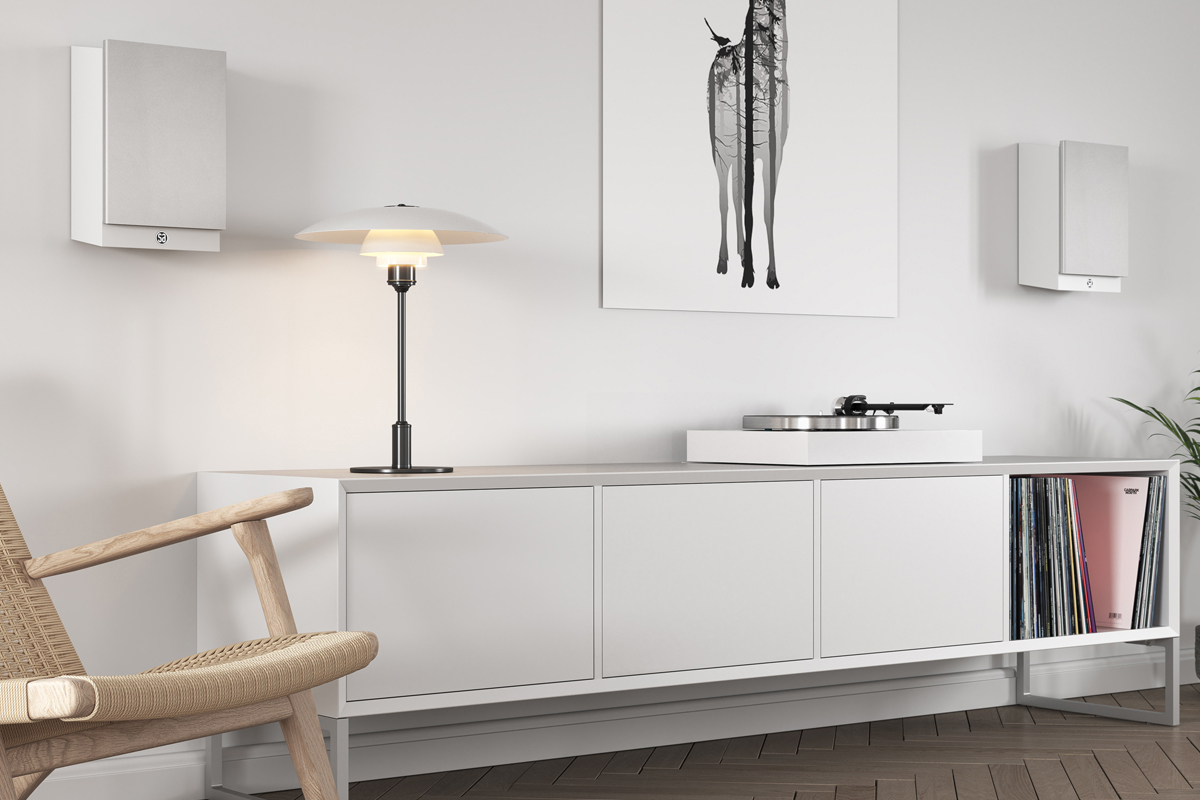 System Audio’s WiSA-compliant Silverback 1 active-on wall speaker can be part of a 7.1-channel surround or 5.1.2 immersive audio system
System Audio’s WiSA-compliant Silverback 1 active-on wall speaker can be part of a 7.1-channel surround or 5.1.2 immersive audio system
The technology has reached a point where cutting cords no longer means cutting corners. Latency issues that plagued early systems have been largely solved. Bandwidth limitations that once made lossless wireless transmission impractical are now irrelevant with current Wi‑Fi infrastructure. Sound-transmission protocols have closed the gap to the point where most listeners won’t notice the difference.
Perhaps the most appealing part for curious two-channel listeners is that you can add surround functionality to recent high-resolution networked streaming systems without compromising on stereo playback, since you don’t need to substitute in a multichannel amp to try it.
After decades of experimentation, wireless surround has matured into a legitimate option for home-audio enthusiasts. For renters who can’t drill holes in walls, homeowners who value aesthetics, and anyone who wants to add immersive audio without compromising their hi-fi, wireless surround makes sense.
. . . AJ Wykes






